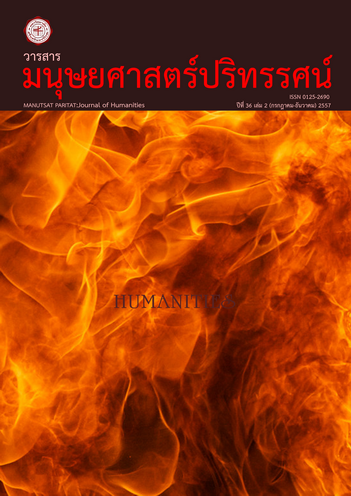คำกริยาชี้นำในทำเนียบภาษาต่างๆ
Abstract
บทคัดย่อ การใช้ภาษาเพื่อให้ผู้อื่นกระทำตามความประสงค์ของตนเป็นสิ่งที่พบมากในชีวิตประจำวัน เรียกว่า วัจนกรรมชี้นำ (Directive speech act) ซึ่งเป็นวัจนกรรมหนึ่งในห้าประเภทที่เซิร์ล (Searle. 1975) จัดไว้ มีประเภทย่อย เช่น การสั่ง การขอร้อง การแนะนำ เป็นต้น บทความนี้มีวัตถุประสงค์เพื่อเปรียบเทียบการใช้คำกริยาชี้นำในทำเนียบภาษากฏหมาย ทำเนียบภาษาสื่อ ทำเนียบภาษาการเมือง และทำเนียบภาษาวิชาการ โดยเก็บข้อมูลทำเนียบภาษาละประมาณ 60,000 คำ และจัดกลุ่มคำกริยาตามระดับความเข้มข้นในการชี้นำ ผลการศึกษาพบว่าคำกริยาชี้นำสามารถจัดเป็น 5 กลุ่มตามมุมมองของผู้รับสาร ประกอบด้วย คำกริยาชี้นำที่แสดงการบังคับ คำกริยาชี้นำที่แสดงการผลักดัน คำกริยาชี้นำที่แสดงการแจ้ง คำกริยาชี้นำที่แสดงการแนะนำ และคำกริยาชี้นำที่แสดงความปรารถนา คำกริยาชี้นำที่แสดงการบังคับมีอำนาจในการชี้นำสูงสุดในขณะที่คำกริยาชี้นำที่แสดงความปรารถนามีอำนาจในการชี้นำต่ำสุด ทำเนียบภาษากฏหมายเป็นทำเนียบภาษาที่ใช้คำกริยาชี้นำมากที่สุด โดยใช้คำกริยาชี้นำที่แสดงการบังคับมากที่สุด ทำเนียบภาษาวิชาการมีลักษณะเด่นในการใช้คำกริยาชี้นำที่แสดงการเสนอแนะ ทำเนียบภาษาการเมืองมีลักษณะเด่นในการใช้คำกริยาชี้นำแสดงความปรารถนาให้ผู้อื่นกระทำตามความประสงค์ของตน ส่วนทำเนียบภาษาสื่อมีลักษณะเด่นในการใช้คำกริยาชี้นำที่แสดงการผลักดัน คำกริยาชี้นำสามารถสะท้อนถึงอำนาจในการชี้นำของผู้ใช้ในแต่ละทำเนียบภาษา คำสำคัญ วัจนกรรมชี้นำ คำกริยาชี้นำ ทำเนียบภาษา ภาษากับอำนาจ ภาษาสื่อ ภาษาการเมือง ภาษาวิชาการ ภาษากฏหมาย Utterances that cause the hearer to take a particular action are commonly found in daily life. Such phenomenon is known as directive speech act; one of Searle’s (1975) five speech acts. Directive speech acts can be classified into various subgroups such as commands, requests, and suggestions. This article aims to compare the occurrence of directive verbs in four language registers; legal language, media language, political language, and academic language and classify them into groups based on directive imposition. The corpus of 60,000 words were collected from each language register. The findings reveal that directive verbs can be classified into five groups based on directive impositions: obligation, urging, informing, suggestions and wishes. While directive verbs denoting obligation have the strongest imposition, those denoting wishes have the weakest imposition. Directive verbs are mostly found in legal language, with the highest frequency in directive verbs of obligation. Directive verbs of suggestions are mostly found in academic language. Political language is characterized by directive verbs of wishes. Media language, on the other hand, is characterized by directive verbs of urging. These directive verbs reflect the power of the users of each language register. Keywords: directives directive verbs language register language and power media language political language academic language legal languageDownloads
Published
2014-12-18
Issue
Section
บทความวิจัย


